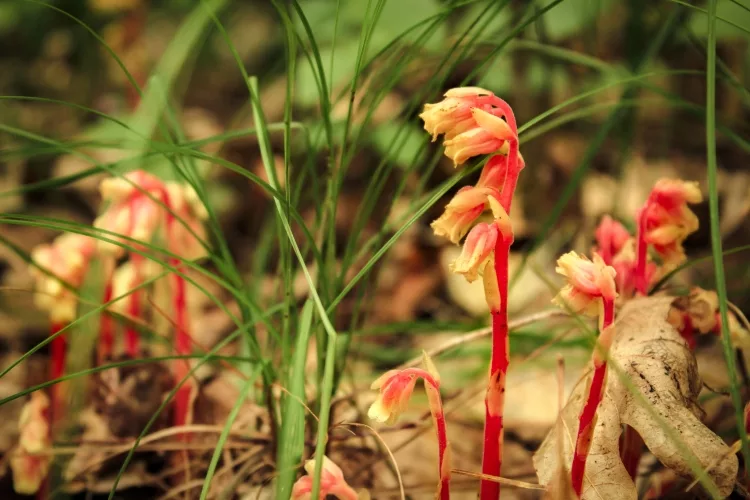reviewed by Truman Perkins
You may think of fungi or parasitic organisms when you hear the word saprophytes. Butit's not that. These florae are, in fact, a unique breed of plants that grow in almost every different region. What makes them different is that despite being incapable of making their food, these plants still thrive.
Incise you want to keep these fascinating creatures in your garden, or you're just curious, we've got you covered in this article.
Contents

The saprophytic plants are unlike the usual green foliage we see around us. Lacking chlorophyll in their leaves, these plants are unable to produce their food from the process of photosynthesis. So, they feed on the decay of dead plants and animals in order to survive. This natural process proves to be extremely beneficial for the ecosystem, as it breaks down this organic material into minerals and nutrients to be reutilized. Without this mechanism, we would be buried under a mountain of unrotten, dead leaves, and logs.
The fungi usually exist in a microscopic form. It only becomes visible with either a prolific amount of growth or fruiting bodies such as mushrooms. The growth might be poisonous, so the presence of a saprophytic plant can be harmful to animals and children if ingested.
Monotropa uniflora, also known as ghost plant, ghost pipe, or Indian pipe, is an herbaceous perennial plant native to Asia and America. The ghost plant is famous for its chilling appearance. It is entirely translucent with waxy white petals and little black flecks, the flower hanging on single peduncles. The ghost plant grows in clusters in temperate regions, usually in the woods.
Corallorhiza, or the Coralroot,refers tothe coral-like appearance of its underground branched rhizomes. The plant is leafless and rootless, lacking chlorophyll, and depends upon mycorrhizal fungi for its carbon acquisition and growth. This is one of the reasons why it is not successfully cultivated.
Cymbidium, commonly known as boat orchids, is an evergreen flowering plant. The flowers can bloom in the dead of winter and can last up to three months. Considerably fit for all conditions, the plant thrives in hot and humid regions.
Mushrooms are often mistaken for vegetables. However, that is not the case. A mushroom is one of the many species of fungi. Usually, when we hear about fungi, unpleasant organisms such as poisonous toadstools or those that cause moldy food appears to our minds. But mushroom can be described as the fruit of a much bigger fungus which grows under the ground and is not just edible, but rather delicious.
The plant gets its name Bird's-nest orchid because its roots tangle up to appear like a bird's nest. The roots form this shape to increase the surface area to absorb more nutrients and carbon from the soil. The plant has no or significantly less chlorophyll, which prevents it from getting its energy directly from the sun.
The unbranched stems of pine drops are sticky and reddish-purple in color, but the little flowers on the stems can vary from white to pink and hang upside-down. Pine drops produce very little chlorophyll and are therefore not green in color and do not conduct photosynthesis.Therefore the scale-like small leaves stick to the stem closely, without having any significant function.
The candy stick is a perennial plant with distinct white and red striped inflorescence along its erect peduncle. The plant has no green foliage, thus using its complicated relationship with fungi to obtain nutrients from the neighboring plants' roots. Allotropa virgata is found around the oak, coniferous, and hardwood forests in relatively cold areas.
The wildflower is relatively less attractive than the other colorful flowers.The mycotrophicplant lacks chlorophyll and other vibrant pigments for the petals. The stem of pinesap is also pale yellow in color and bends after reaching a specific height.
Lathraea squamation, the common toothwort, is a leafless plant having broad scales around its stem that might seem like its leaves because of their wing-like appearance. The flower is tubular or tier-cowl in shapeand is covered with numerous little spikes and hair. The toothwort flower faces one side of the spire and is always stooping slightly. Parasitic on the roots of hazel, it is occasionally found on other trees in the shades and woodlands.
Commonly known as ghost plants,Voyria tenella is an herbaceous perennial plantnative to warm temperate and tropical lands. The flower growing at the pallid stems' tips varies in color from white to yellow, but the roots are thick and dense to absorb the nutrients.Like all saprophytic plants, they are capable of living in very dark conditions, such as deep forest grounds, because they no longer gain energy from sunlight.
There are many different types of saprophytic plants that you can find in your average household garden.
This is quite a common mushroom, mainly found in Asia. It's distinguished mainly by its unique golden yellow hue that attracts the eye from afar. Although these mushrooms are potentially dangerous as they are poisonous, they can be eaten after certain preservation methods. What makes it more unique is its distinctive smell. The golden chanterelles have a faint hint and musk of apricots, which attributes in its flavor as well.
Also known as the Indian pipe plant, these saprophytes are perhaps nature's Halloween décor. These plants are distinguished by their pale color and ghostly shape. Sometimes these can have slight pigmentation of pink hues in the lightest shade. This plant is white and has no chlorophyll in it. The ghost plant is not just an ornamental beauty; it has been known to be for medicinal purposes at the end of the 19th century.
Also known as the birthwort, this plant is found in the most diverse climates. Although these flora species are toxic and can be poisonous if ingested, they have been used as ornamental plants for years. Horticulturists have used these in gardens and other laces because of their attractive looking flowers. However, beware of the pungent, unpleasant smell some of the species has.
We often consider orchids as everyday flowers or plants. In reality, it's quite different. These pants are semi heterotrophs, mainly causing them to come under the saprophytic category. You can find a variety of orchids; however, saprophytic orchids are those that require the help of fungi to grow.
You may get the idea of why it's called a turkey tail. It's because of the shape and pattern this fungus possesses. This fungus is not exactly cultivated; it usually grows on tree trunks and the ground. They are not precisely the ornamental type, but the fact that this fungus can display various colors in one go is something that makes it pretty unique.
The most common edible mushrooms are also saprophytes themselves. These are the common creamy white colored mushrooms we consume in various dishes and can be grown in gardens or cultivated for sale purposes.
These are another form of saprophytes you could have in your garden. They are distinguished by their sweet nutmeg and cinnamon scent and are excellent decomposers.
Red fleshy looking, this can be confused for a piece of meat. This is mainly in the US and has been found in forests. It can be kept in gardens where there is a chilly climate, and they act as decomposers as well.
Saprophytes may be told as a nuisance, but it's quite the contrary. They help in the decomposition and degradation of waste materials and help release nutrition in their surroundings. Those minerals that are released in the environment, are then in turn, absorbed by plants surrounding. All in all, it helps maintain a healthy ecosystem in the area they are grown. These creatures will help decompose waste materials, which also helps in cleaning the surroundings as well. Hence, therefore, these little creatures are definitely a blessing in disguise.
Classroom Project: 10 Easy Growing Beans For A Science Experiment
 |
 |
 |
 |

About Truman Perkins
Truman Perkins is a Detroit-based SEO consultant who's been in the business for over a decade. He got his start helping friends and clients get their websites off the ground, and he continues to do so today. In his free time, Truman enjoys learning and writing about gardening - something he believes is a natural stress reliever. He lives with his wife, Jenny, and their twins in Detroit.
 |
 |
 |
 |
Check These Out
Get new FREE Gifts. Or latest free growing e-books from our latest works.
Disable Ad block to reveal all the links. Once done, hit a button below
 |
 |
 |
 |